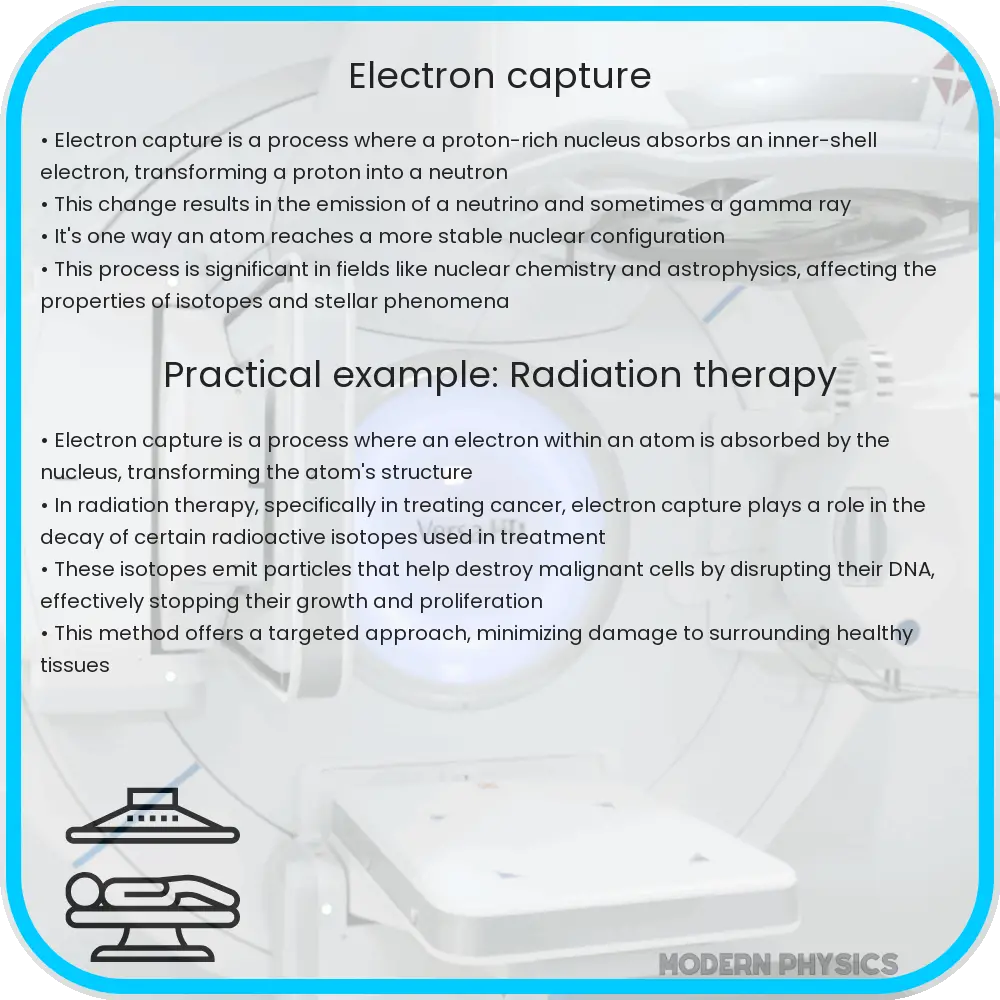Learn about electron capture, a nuclear process where an atom’s nucleus captures an electron, leading to elemental transformation and significant implications in various scientific fields.

Understanding Electron Capture
Electron capture is a fundamental process in nuclear and atomic physics where an atom’s nucleus captures one of the atom’s own electrons. This process results in a change to the nucleus that impacts its atomic and physical properties. It is a type of beta decay, key to the puzzle of how atoms undergo change over time.
The Process of Electron Capture
In electron capture, an electron from the innermost orbital of an atom (typically a K-shell electron) is pulled into the nucleus where it combines with a proton to form a neutron and releases a neutrino, which exits the nucleus. The general equation representing this process is:
\[ p^+ + e^- \rightarrow n + \nu_e \]
Where \( p^+ \) represents a proton, \( e^- \) represents an electron, \( n \) denotes a neutron, and \( \nu_e \) signifies a neutrino. This neutrino, which is nearly massless and electrically neutral, carries away some of the energy and momentum.
The decreased atomic number as a result of this process changes the element. For instance, if potassium-40 (with 19 protons) undergoes electron capture, it converts into argon-40 (with 18 protons). Despite keeping the same mass number, the transformation alters the element into a completely different one with varied chemical properties.
Effects of Electron Capture
Electron capture has significant implications on both atomic and cosmological scales:
- Isotope Stability: Many isotopes use electron capture as a way to move to a more stable nuclear state. This process helps clarify the principles of nuclear stability and the mechanisms that influence radioactive decay.
- Energy Release: The process leads to the emission of a neutrino and sometimes gamma rays, releasing energy often utilized in various scientific investigations, including astrophysics and nuclear engineering.
- Elemental Transformation: As atoms change their atomic number through electron capture, elemental transmutation occurs, which is crucial for understanding chemical processes and synthesizing new materials.
Examples of Electron Capture
Electron capture is not just a theoretical construct but occurs naturally and can be observed in many scenarios:
- Astronomy: In stars, electron capture occurs in high-density environments where electrons are forced into protons, creating neutrons and neutrinos. This process plays a critical role in the life and death of medium-sized stars, contributing to phenomena such as supernovae.
- Medical Imaging: Certain isotopes that undergo electron capture are used in diagnostic techniques, such as in PET scans. The isotopes emits neutrinos and gamma rays, which are then detected to produce images of the human body, assisting in medical examinations and treatments.
- Carbon Dating: Although electron capture is less known in this field compared to beta decay, isotopes undergoing this type of decay can also provide data similar to that obtained from more traditional carbon dating methods.
Understanding electron capture deepens our insights into nuclear reactions and their applications across different fields, from medical science to environmental studies and beyond. This process proves integral for the synthesis and behavior of elements, guiding both theoretical studies and practical applications in modern technology and research.
Measurement and Detection of Electron Capture
To study and verify electron capture, scientists utilize sophisticated detectors and measurement techniques. One common method is using spectrometry to detect gamma rays and neutrinos emitted during the decay process. This allows researchers not only to observe the occurrence of electron capture but also to measure the energy levels and other properties that are crucial for understanding the nuances of this transformation.
Spectrometry instruments can be set up around experimental setups involving isotopes known to undergo electron capture. By monitoring the emissions and absorbing any other secondary particles, scientists can accurately trace the path that leads from the captured electron to the final products of decay.
Significance in Environmental and Geological Studies
Electron capture also plays a vital role in environmental and geological studies:
- Radioisotope Dating: Elements that undergo electron capture are used in dating geological samples. By measuring the daughter isotopes and remaining parent isotopes, scientists can determine the age of rocks and other geological features.
- Environmental Tracing: Tracing the pathways of isotopes that undergo electron capture helps scientists monitor and study pollution and its sources, as well as understanding natural processes in the environment like the nitrogen cycle.
Conclusion
Electron capture is a profound process that not only changes the identity of an element but also has versatile applications across various scientific fields. From helping to determine the ages of rocks to assisting in medical diagnostics, the effects of electron capture extend beyond simple nuclear transformations. Each captured electron nudges us closer to deeper understanding of the universe, from its smallest components to its largest processes.
By studying electron capture, scientists continue to unravel the complex dance of particles that govern the physical world. This knowledge propels forward innovations and provides the deep insights necessary to solve some of the most challenging problems in modern science, making the study of this process essential for continued progress in multiple disciplines.
